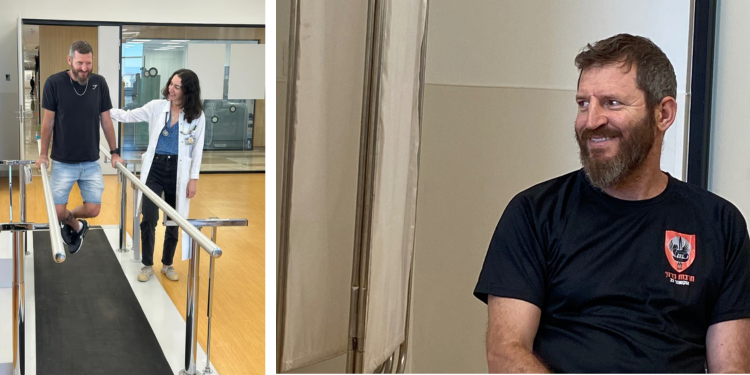
Article originally published in YNET
In January 2024, Yonati Bahat’s life changed in an instant. The 48-year-old husband and father of two from Nes Harim found himself in critical condition after sustaining multiple gunshot wounds. After three weeks in the intensive care unit at Hadassah Ein Kerem on a ventilator, followed by two weeks in the surgical ward, he began his challenging and transformative journey at the Gandel Rehabilitation Center, which had been fast-tracked to treat wounded soldiers and civilians from the war.
The First Steps: From Bed to Chair
“Rehabilitation began the moment I woke up from sedation and ventilation,” Bahat recalls. “In the ICU, a determined physiotherapist worked to activate my lungs. It was extremely difficult—I just wanted to rest, but they knew exactly how to push and when to ease up.”
His first significant milestone was moving from bed to a wheelchair. “The swelling from my injuries made every movement—lifting a leg, shifting my body—seem impossible,” he explains. “The physiotherapists’ persistence and guidance showed me that the impossible could become possible.”
Rehabilitation as a Rollercoaster
Three months post-injury, Bahat underwent shoulder replacement surgery. “It was a major turning point but also incredibly frustrating,” he shares. “I had been making progress—walking, moving—and suddenly, after surgery, I felt like I was back at square one.”
“Rehabilitation is not a straight line forward,” he reflects. “It’s a rollercoaster. You make progress, face setbacks, and need an enormous amount of patience.”
Emotional Struggles: From Battlefield to Hospital Bed
One of Bahat’s greatest challenges was transitioning from a soldier to a patient. “In combat, you’re independent, capable. Suddenly, you’re in a situation where someone is bathing you and helping with daily tasks,” he says. “The contrast was immense, but it taught me humility and acceptance.”
For wounded soldiers, the abrupt disconnection from their units and missions is particularly difficult. “You go from being on the frontlines, part of a mission, to lying in a hospital bed while your comrades are still in the field.”
A Family in White: The Dedication of the GRC Team
Bahat describes the staff at Hadassah’s Gandel Rehabilitation Center as extraordinary. “They’re more than medical professionals; they’re a family. They know me, my wife, and my children. They see when I’m having a tough day and provide support beyond just medical care.”
Dr. Shir Shabat, a senior rehabilitation specialist at Hadassah, underscores the complexity of Bahat’s case: “He arrived with severe injuries requiring a personalised, multidisciplinary approach to help him regain independence.”
Hadassah’s holistic rehabilitation program integrates traditional therapies with alternative approaches, such as acupuncture, hydrotherapy, and animal-assisted therapy, tailoring care to the needs and preferences of each patient.
A Message of Hope: "Take It One Step at a Time"
“I’m still on this journey,” Bahat admits. “I’m not fully recovered physically or mentally, but I’m moving forward.”
His advice to others beginning their rehabilitation journey: “Be patient. It’s a long road with highs and lows. Focus on the next breath, the next step. Celebrate small victories and don’t dwell too much on the future.”
Rehabilitation Is a Partnership
“Rehabilitation is as critical as life-saving treatment in the ICU,” Bahat concludes. “It requires a shared commitment between the patient and the medical team. The journey is only possible when both give it their all.”
Through Bahat’s story, we are reminded of the resilience of the human spirit and the profound impact of dedicated care at the Gandel Rehabilitation Center.
Back to Newsletter